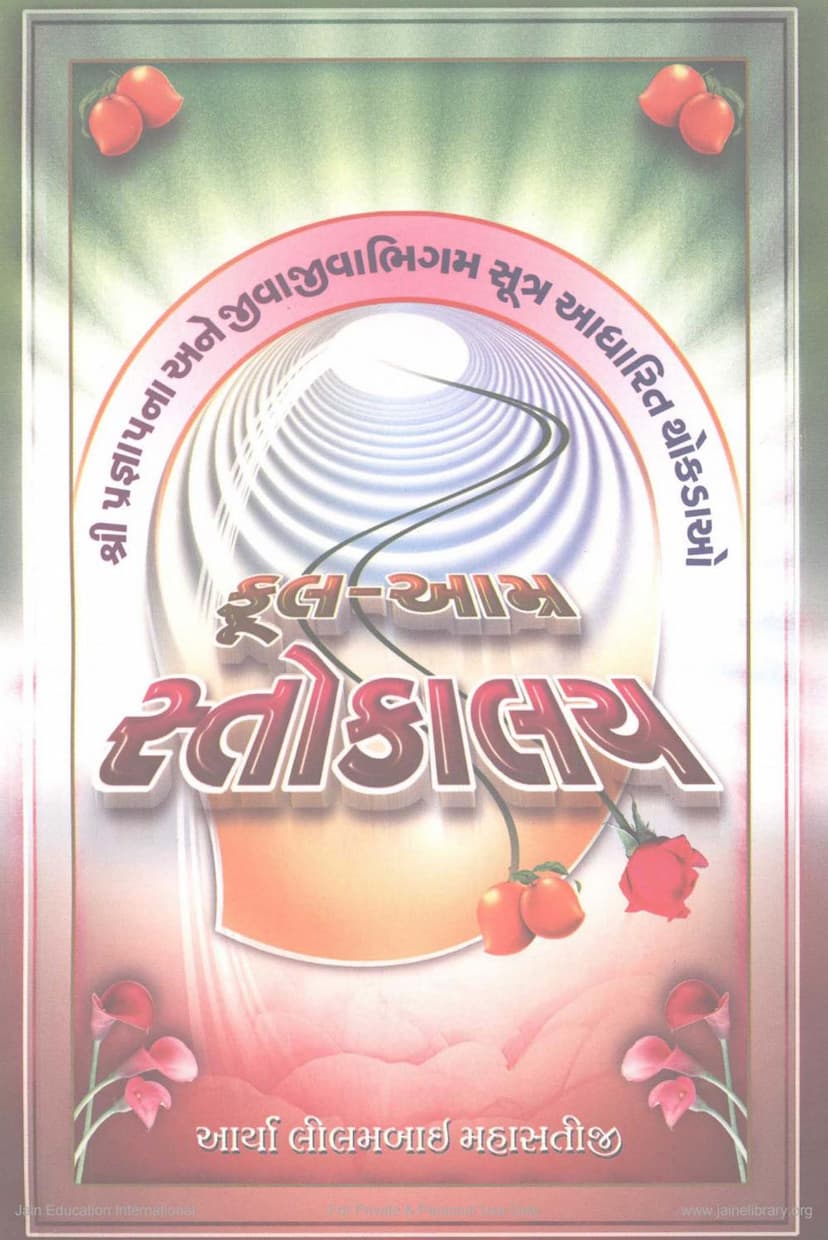Phool Amra Stokalay
Added to library: September 2, 2025

Summary
This book, "Phool Amra Stokalay" by Lilambai Mahasati, published by Guru Pran Foundation Rajkot, is a collection of "thokdas" (short expositions) based on the Jain scriptures, Shri Prajnapana Sutra and Shri Jivajivabhigam Sutra. It is dedicated to the 52nd death anniversary of the late Param Pujya Soumyamurti Ambabai M.
The book is compiled and edited by Pujya Lilambai M. with the assistance of Dr. Pujya Aarti Bai M. and Pujya Subodhikabai M. It was published on Sunday, November 30, 2005, with a first print run of 1500 copies, priced at Rs. 40.
The initial pages include heartfelt tributes from the editor, Arya Lilambai Mahasati, to her revered gurus, particularly Pujya Ambabai M. and Pujya Phoolkunverbai M., detailing the immense influence they had on her spiritual and intellectual journey, encouraging her to undertake the monumental task of translating and compiling the Agamas. She expresses deep gratitude for their teachings, blessings, and the opportunities they provided.
The text then delves into the life and teachings of two significant spiritual guides:
-
Pujya Phoolkunverbai Mahasati: Her life is presented as a testament to spiritual strength and devotion. She was initiated into the Jain path at the age of 33 in the lineage of the revered Dungarsinhji Maharaj Saheb and Hirabai M., Velbai M., Mansukhkunverbai M., and Devkunvarbai M. Her life was marked by profound spiritual understanding, mastery of languages like Sanskrit, Prakrit, and Ardhamagadhi, and the ability to move and inspire people through her eloquent discourses, singing devotional songs, and reciting epic poems. Despite not having disciples of her own, her spiritual legacy was carried forward by her guru-sisters' disciples, including Pujya Muktabai M. and Pujya Lilambai M. She passed away peacefully at Prempara village in 2018 (Samvat).
-
Pujya Ambabai Mahasati: Her life story highlights her transformation from a householder to a devout soul. After enduring personal tragedies, including the loss of her husband and child, she found solace and purpose in spirituality. Initiated at the age of 36, she was known for her gentle nature, inner strength, and commitment to service. Her life's motto was "Service is Religion." She is remembered for her dedication to serving her elder guru-sisters, her active participation in propagating Jain principles, and her ability to uplift and guide her disciples. She attained nirvana in Junagadh in Samvat 2010 (Jeth Sud Nom).
-
Pujya Ushabai M.: The life narrative of Pujya Ushabai M. is presented as a journey of profound dedication. A disciple of Pujya Mukta-Lilam Guruni, she is described as someone who overcame the limitations of life and death through her spiritual practices. Her life was dedicated to spiritual discipline and profound meditation, ultimately leading her to spiritual enlightenment. She is credited with initiating the "Gurupran Agam Batrisi" publication project, a significant undertaking in spreading Jain scriptures. She excelled in her studies, mastering various Jain texts and languages, and was instrumental in the establishment of the Gurupran Foundation. Her life was also marked by rigorous austerities and a deep commitment to the welfare of all beings.
The subsequent sections of the book are detailed expositions ("thokdas") based on the Jain scriptures, covering various topics:
-
Shri Prajnapana Sutra: This part of the book discusses classifications of human beings (Arya and Anarya), their subdivisions based on Siddhi and lack thereof, various types of knowledge (Jnana), vision (Darshana), and conduct (Charitra). It also elaborates on the concept of "Sthan" (locations of existence) and the various types of living beings and their classifications based on different criteria.
-
Shri Jivajivabhigam Sutra: This section focuses on the classifications of souls, the nature of animate (Jiva) and inanimate (Ajeeva) substances, the subtle distinctions between them, and their respective locations and characteristics within the universe. It further details the "Alpabudhutva" (minority/majority) of beings based on various factors like life span, senses, and abilities, covering 800 specific points ("bols"). It also includes detailed discussions on beings based on their actions, states of consciousness (Leshya), and their karmic connections.
The text includes charts and diagrams to illustrate complex concepts, such as the structure of the universe and the classification of living beings. It also provides detailed explanations of "thokdas" related to the subtle nuances of life forms, their karmic bonds, lifespan, and spiritual progress through various stages. The overall aim of the book is to provide accessible explanations of profound Jain philosophical and cosmological concepts.